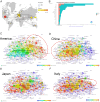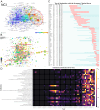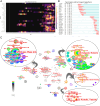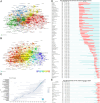The global trends and distribution in tumor-infiltrating lymphocytes over the past 49 years: bibliometric and visualized analysis
- PMID: 39835135
- PMCID: PMC11743541
- DOI: 10.3389/fimmu.2024.1511866
The global trends and distribution in tumor-infiltrating lymphocytes over the past 49 years: bibliometric and visualized analysis
Abstract
Background: The body of research on tumor-infiltrating lymphocytes (TILs) is expanding rapidly; yet, a comprehensive analysis of related publications has been notably absent.
Objective: This study utilizes bibliometric methodologies to identify emerging research hotspots and to map the distribution of tumor-infiltrating lymphocyte research.
Methods: Literature from the Web of Science database was analyzed and visualized using VOSviewer, CiteSpace, Scimago Graphica, R-bibliometrix, and R packages.
Results: Research on tumor-infiltrating lymphocytes began in 1975 and has experienced significant growth, particularly after 2015. Leading contributors include the United States, the National Cancer Institute, the journal Cancer Immunology Immunotherapy, and researcher Steven A. Rosenberg. Other prominent contributors include China, the National Institutes of Health, researcher Roberto Salgado, and the Journal of Immunology. Prominent institutions in the USA and Europe occupy central roles within collaborative networks. Financial support plays a pivotal role in driving research advancements. Keyword clustering analysis reveals four primary knowledge domains: adoptive cell therapy; the prognostic value of TILs; PD-1/PD-L1 and TILs; and prognostic studies of TILs across various cancers. Keyword and reference analyses further indicate that "adoptive cell therapy," "the prognostic value of TILs," and "immune checkpoint inhibitors and TILs" are central themes in current and future research. Combination therapies; tumor neoantigens; gene editing; dominant population selection of TILs therapy; TILs in Tumor microenvironment; emerging predictive biomarkers; TILs in predicting the efficacy of neoadjuvant chemotherapy and immunotherapy; the relationship between TILs and PD-L1; TIL-based patient stratification; tertiary lymphoid structures; and TIL evaluation through digital pathology and artificial intelligence are identified as key areas of interest.
Conclusions: This analysis highlights the increasing academic focus on tumor-infiltrating lymphocyte research and identifies key recent themes in the field such as prognostic value of TILs, personalized treatments, and combination therapies.
Keywords: PD-L1; adoptive cell therapy; bibliometrics; predictive biomarker; tumor-infiltrating lymphocytes.
Copyright © 2025 Wu, Luo, Wang, Qiao, Li and Liu.
Conflict of interest statement
The authors declare that the research was conducted in the absence of any commercial or financial relationships that could be construed as a potential conflict of interest.
Figures








Similar articles
-
A bibliometric insight into nanomaterials in vaccine: trends, collaborations, and future avenues.Front Immunol. 2024 Aug 12;15:1420216. doi: 10.3389/fimmu.2024.1420216. eCollection 2024. Front Immunol. 2024. PMID: 39188723 Free PMC article.
-
Thematic trends and knowledge-map of tumor-infiltrating lymphocytes in breast cancer: a scientometric analysis.Front Oncol. 2024 Nov 1;14:1438091. doi: 10.3389/fonc.2024.1438091. eCollection 2024. Front Oncol. 2024. PMID: 39555450 Free PMC article.
-
Global trends in tertiary lymphoid structures: a bibliometric analysis from 2014 to 2023.Front Immunol. 2024 Nov 15;15:1475062. doi: 10.3389/fimmu.2024.1475062. eCollection 2024. Front Immunol. 2024. PMID: 39620224 Free PMC article.
-
Global trends in tumor-associated neutrophil research: a bibliometric and visual analysis.Front Immunol. 2025 Mar 14;16:1478092. doi: 10.3389/fimmu.2025.1478092. eCollection 2025. Front Immunol. 2025. PMID: 40160822 Free PMC article.
-
Emerging research themes in ferroptosis research for non-small cell lung cancer: a bibliometric and visualized analysis.Front Immunol. 2025 May 16;16:1563108. doi: 10.3389/fimmu.2025.1563108. eCollection 2025. Front Immunol. 2025. PMID: 40453086 Free PMC article.
References
MeSH terms
LinkOut - more resources
Full Text Sources
Medical
Research Materials
Miscellaneous

